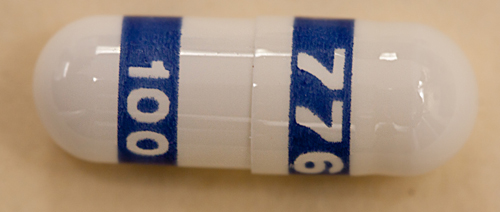Therapeutic Classification: antirheumatics
Pharmacologic Classification: cox 2 inhibitors
Absorption: Bioavailability unknown.
Distribution: Extensively distributed to tissues.
Protein Binding: 97%.
Metabolism/Excretion: Mostly metabolized by the liver via the CYP2C9 isoenzyme; the CYP2C9 isoenzyme exhibits genetic polymorphism; poor metabolizers may have significantly ↑ celecoxib concentrations and an ↑ risk of adverse effects; <3% excreted unchanged in urine and feces.
Half-life: 11 hr.
Contraindicated in:
- Hypersensitivity
- Cross-sensitivity may exist with other NSAIDs, including aspirin
- History of allergic-type reactions to sulfonamides
- History of allergic-type reactions to aspirin or other NSAIDs, including the aspirin triad (asthma, nasal polyps, and severe hypersensitivity reactions to aspirin)
- Advanced renal disease
- Severe hepatic impairment
- Coronary artery bypass graft (CABG) surgery
- HF
- OB: Avoid use after 30 wk gestation.
Use Cautiously in:
- Cardiovascular disease or risk factors for cardiovascular disease (may ↑ risk of serious cardiovascular thrombotic events, myocardial infarction, and stroke, especially with prolonged use or use of higher doses); avoid use in patients with recent MI or HF
- Renal impairment, hepatic impairment, dehydration, or concurrent diuretic, ACE inhibitor, or angiotensin receptor blocker therapy (↑ risk of renal impairment)
- History of long duration of NSAID use, smoking, alcohol use, advanced liver disease, coagulopathy, and poor general health (↑ risk of GI bleeding)
- Hypertension or fluid retention
- Asthma
- Patients who are known or suspected to be poor CYP2C9 metabolizers (↓ initial dose by 50%; in patients with juvenile rheumatoid arthritis, use alternative treatment)
- Asthma
- OB: Use at or after 20 wk gestation may cause fetal or neonatal renal impairment; if treatment is necessary between 20 wk and 30 wk gestation, limit use to the lowest effective dose and shortest duration possible
- Pedi: Safety not established in children <2 yr or for longer than 6 mo
- Geri: ↑risk of GI bleeding and renal impairment in older adults.
Exercise Extreme Caution in:
CV: edema, HF, hypertension, MI, THROMBOSIS.
Derm: ACUTE GENERALIZED EXANTHEMATOUS PUSTULOSIS, DRUG REACTION WITH EOSINOPHILIA AND SYSTEMIC SYMPTOMS (DRESS), EXFOLIATIVE DERMATITIS, rash, STEVENS-JOHNSON SYNDROME (SJS), TOXIC EPIDERMAL NECROLYSIS.
F and E: hyperkalemia.
GI: abdominal pain, diarrhea, dyspepsia, flatulence, GI BLEEDING, nausea.
GU: renal impairment.
Hemat: anemia.
Neuro: dizziness, headache, insomnia, STROKE.
Osteoarthritis
- PO (Adults): 200 mg once daily or 100 mg twice daily. CYP2C9 poor metabolizers:↓ dose by 50%.
Hepatic Impairment
- PO (Adults): Moderate hepatic impairment:↓ dose by 50%.
Rheumatoid Arthritis
- PO (Adults): 100–200 mg twice daily (capsules). CYP2C9 poor metabolizers:↓ dose by 50%.
Hepatic Impairment
- PO (Adults): Moderate hepatic impairment:↓ dose by 50%.
Ankylosing Spondylitis
- PO (Adults): 200 mg once daily (capsules) or 100 mg twice daily (capsules); may ↑ dose after 6 wk to 400 mg/day. CYP2C9 poor metabolizers:↓ dose by 50%.
Hepatic Impairment
- PO (Adults): Moderate hepatic impairment:↓ dose by 50%.
Juvenile Rheumatoid Arthritis
- PO (Children
 2 yr, 10–25 kg): 50 mg twice daily (capsules).
2 yr, 10–25 kg): 50 mg twice daily (capsules). - PO (Children
 2 yr,
2 yr,  25 kg): 100 mg twice daily (capsules).
25 kg): 100 mg twice daily (capsules).
Hepatic Impairment
- PO (Children
 2 yr): Moderate hepatic impairment:↓ dose by 50%.
2 yr): Moderate hepatic impairment:↓ dose by 50%.
Acute Pain or Primary Dysmenorrhea
- PO (Adults): 400 mg initially, then a 200-mg dose if needed on the first day; then 200 mg twice daily as needed (capsules). CYP2C9 poor metabolizers:↓ dose by 50%.
Hepatic Impairment
- PO (Adults): Moderate hepatic impairment:↓ dose by 50%.
Acute Treatment of Migraine
- PO (Adults): 120 mg as a single dose (not to exceed 120 mg/24 hr). CYP2C9 poor metabolizers: 60 mg as a single dose (not to exceed 60 mg/24 hr).
Hepatic Impairment
- PO (Adults): Moderate hepatic impairment: 60 mg as a single dose (not to exceed 60 mg/24 hr).
 2 yr, 10–25 kg): 50 mg twice daily (capsules).
2 yr, 10–25 kg): 50 mg twice daily (capsules). 2 yr,
2 yr,  25 kg): 100 mg twice daily (capsules).
25 kg): 100 mg twice daily (capsules). 2 yr): Moderate hepatic impairment:↓ dose by 50%.
2 yr): Moderate hepatic impairment:↓ dose by 50%. 10 days per month to avoid medication-overuse headache.
10 days per month to avoid medication-overuse headache.